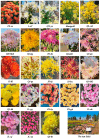Screening of Profitable Chrysanthemums for the Phytoremediation of Cadmium-Contaminated Soils
- PMID: 40423438
- PMCID: PMC12115758
- DOI: 10.3390/toxics13050360
Screening of Profitable Chrysanthemums for the Phytoremediation of Cadmium-Contaminated Soils
Abstract
To explore the phytoremediation effect of ornamental chrysanthemums on cadmium (Cd)-contaminated farmland soil, a 2-year field trial was conducted on 23 chrysanthemum cultivars in Cd-contaminated soil in Zhejiang Province, China. The biomass yields, Cd content of the plants, Cd enrichment coefficient, and remediation efficiency were evaluated. The aboveground biomass of the tested chrysanthemums was 67.10-166.08 g/plant, the aboveground Cd content was 1.97-5.92 mg kg-1, and the Cd enrichment coefficient was 2.98-9.84. In a screening test of twenty-three chrysanthemum cultivars, six cultivars, such as marigolds, were characterized by high cadmium accumulation, with the average cadmium accumulation of chrysanthemums exceeding 0.6 mg per plant, and the remediation of rhizosphere-contaminated soils took only 4-5 years. Fourteen chrysanthemum cultivars have good multiple-cropping characteristics, and five multiple-cropping chrysanthemum cultivars, such as QX-yz, have high heavy metal tolerance. The multiple-cropping JL-yg cultivars with higher Cd accumulation could be recommended for the remediation of Cd-contaminated farmland. The application of bamboo vinegar to the chrysanthemum rhizosphere effectively promoted Cd absorption. After estimating the economic benefits of artificially planting five dominant varieties of chrysanthemums for polluted farmland remediation, it is concluded that the annual income of a worker can be slightly higher than the average annual income level of local residents.
Keywords: cadmium remove; chrysanthemum cultivars; phytoremediation; soil contamination.
Conflict of interest statement
Authors Jinqiu Song, Chunzheng Dai and Nanchong Zhong were employed by the company Zhejiang Zhezhong Geological Engineering Investigation Institute Co., Ltd. Author Chenjiang Jin was employed by the company Zhejiang Geology and Mineral Technology Co., Ltd. The re-maining authors declare that the research was conducted in the absence of any commercial or fi-nancial relationships that could be construed as a potential conflict of interest.
Figures





References
-
- Xia X., Yang Z., Yu T., Zhang C., Hou Q. Predicting spatial and temporal variation of Cd concentration in rice grains in the Lower Changjiang Plain during 2004–2014 based on soil geochemical survey data with GIS. J. Geochem. Explor. 2018;200:276–283. doi: 10.1016/j.gexplo.2018.08.004. - DOI
-
- Kalyvas G., Bilias F., Gasparatos D., Zafeiriou I., Eissa R., Karamountzou E., Massas I. Enhanced As, Pb and Zn uptake by Helianthus annuus from a Heavily contaminated mining soil amended with edta and olive mill wastewater due to increased element mobilization, as verified by sequential extraction schemes. Environments. 2022;9:61. doi: 10.3390/environments9050061. - DOI
Grants and funding
- No. 2020006/Science and Technology Programs of Department of Natural Resources of Zhejiang Province, China
- No. 2023021/Science and Technology Programs of Department of Natural Resources of Zhejiang Province, China
- No. 2020-45/Science and Technology Programs of Department of Natural Resources of Zhejiang Province, China
- No. 2021XM0040/Ecological Environment Scientific Research Achievement Promotion Program of Zhejiang Province
- 2022-3-065/Science and Technology Project of Jinhua City
LinkOut - more resources
Full Text Sources

